Massachusetts Currency
December 7, 1775 - Sword in hand
An emission of £75,000 legal tender bills of credit engraved and printed by Paul Revere in Boston. This was the second of four emissions of notes by Revere in his series featuring an American soldier on the back, often called the "Sword in hand" issues. In this December emission approximately 6,250 bills were issued for each denomination and were to be redeemable in "Lawfull Money" on December 7, 1781. However bills of 6s or higher from emissions before November 1776 were recalled for exchange by an act of October 13, 1777, which was amended three times, successively extending the date for redemption until December 1, 1778, at which time the notes became invalid and unredeemable.Fifteen of the sixteen denominations in this issue differed from the sixteen denominations in the first emission of the series, issued about four months earlier in August. Only the 10s denomination is common to both emissions. Nevertheless, the two sets of plates used to print the notes were the same ones used for the previous issue of August 18, 1775 but with alterations to reflect the new date of issue and the differing denominations.
In a letter Revere wrote to the Massachusetts House of Representatives on December 8, 1775 he agreed to:
"Engrave the Plates & make the necessary alterations in the same ... As the alteration & engraving will not be quite so much work as the last [referring to the first Sword in Hand emission of August 18], I agree to alow [sic] thirty Shillings L. [Lawful] Money out of the whole."The letter had been written from Watertown, where the legislature was meeting and apparently was quickly delivered and immediately acted upon, for on the same day, December 8th, the House resolved:
"That Henry Gardner Esquire; Receiver General of this Colony be, and hereby is directed to deliver unto Mr. Paul revere, Engraver, the two Pair of Copper-Plates, now in the keeping of said Receiver General, from which the last Emission of Bills was struck off; one Pair of said Plates to be delivered upon the return of the other, and that Mr. Revere be directed to proceed with all expedition, in the cutting or engraving a New Sett of Plates for the striking off Bills of public Credit, ... And that he be allowed for said Service One Penny and a Half Penny O.T. [Old Tenor] for each Bill he shall strike off, he finding the Paper, and every Material that shall be necessary, and allowing a deduction to be made from the forgoing Allowance of the Sum of Thirty Shillings Lawful-Money for the Advantage he will receive from the old Plates ..." [House Journal, p. 28].
The copper plate used to print the front of the 8d-7s denominations is extant in the Massachusetts State Archives, unfortunately the plate for the back of these notes is lost. The plate used for the front of 10s-48s denominations was further modified and reused for the final two emissions of this series and has not survived. However, the plate for the back of the higher denominations does survive. As it was modified for the final emission of this series, dated November 17, 1776, it is discussed under that emission. Also, a copper plate for the front of a counterfeit 42s note of the December 7th emission survives in the Montrose Natural History and Antiquarian Society, Montrose, Scotland. That plate now has a hole in the oval where the serial number would be written.
As on the first emission, the front of each note has a small oval vignette with a ship docked at a harbor or a tree; the design differs on each denomination. The back depicts a colonial American soldier (sometimes called a minuteman) with a sword in his right hand and copy of the Magna Charta in his left. This is a document signed by King John in 1215, popularly interpreted as conferring rights to all free Englishmen. Above is the motto "Issued in defence of American Liberty" and below is the motto of Massachusetts "Ense petit placidam sub Libertate Quietem." (By the sword one seeks peace under tranquil liberty). Denominations for the December 7, 1775 issue were: 8d, 1s4d, 1s6d, 2s8d, 3s, 3s4d, 4s6d, 7s, 10s, 14s, 16s, 22s, 28s, 36s, 42s and 48s.
obv
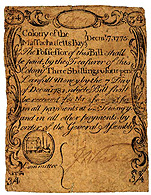 rev
rev 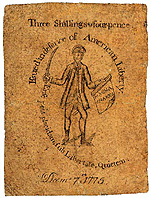
3s4d Serial Number: 5841 (?) (faded) MA 12/07/75
Signers: Joseph Wheeler (others faded).
Size: not available
Comments: The oval vignette differs somewhat on each denomination. On this denomination is a ship docked at a harbor with a building to the left. The back depicts a colonial soldier with a sword in his right hand and a copy of the Magna Charta in his left. Above is the motto "Issued in defence of American Liberty" and below is the motto of Massachusetts "Ense petit placidam sub Libertate Quietem" (By the sword one seeks peace under tranquil liberty).
Courtesy of Early American History Auctions, Inc. Images used with permission from their on-line auction catalog for the auction of July 12, 1997, lot 184.
obv
 rev
rev 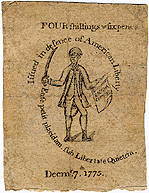
4s6d Serial Number: ???8 (faded) MA 12/07/75
Signers: William Pynchon (others faded).
Size: 98 x 74mm (front border design: 88 x 71mm).
Comments: The oval vignette differs somewhat on each denomination. On this denomination is a ship docked at a harbor with a building to the right and a small building to the left in the background. The back depicts a colonial soldier with a sword in his right hand and a copy of the Magna Charta in his left. Above is the motto "Issued in defence of American Liberty" and below is the motto of Massachusetts "Ense petit placidam sub Libertate Quietem" (By the sword one seeks peace under tranquil liberty). The serial number and signatures on our example are faded. The bottom border is a sheet selvege portion.
Provenance: EANA mail bid auction 1/13/96 lot 366. Purchased through the Robert H. Gore, Jr. Numismatic Endowment.
obv
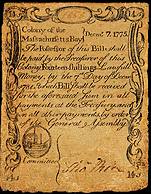 rev
rev 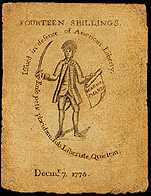
14s Serial Number: 1656 (faded) MA 12/07/75
Signers: Thomas Rice (others faded).
Size: not available
Comments: The oval vignette differs somewhat on each denomination. On this denomination is a ship docked at a harbor with a building to the left. The back depicts a colonial soldier with a sword in his right hand and a copy of the Magna Charta in his left. Above is the motto "Issued in defence of American Liberty" and below is the motto of Massachusetts "Ense petit placidam sub Libertate Quietem" (By the sword one seeks peace under tranquil liberty).
Courtesy of Early American Numismatic Auctions, Inc. Images used with permission from their on-line auction catalog for the auction of November 16, 1996, lot 591.